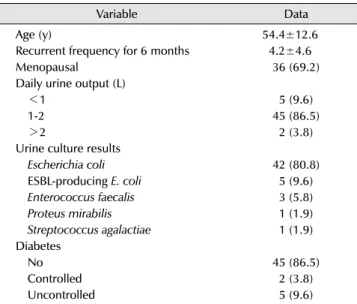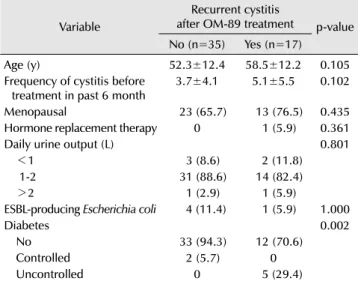42
ISSN 2465-8243(Print) / ISSN: 2465-8510(Online) https://doi.org/10.14777/uti.2019.14.2.42 Urogenit Tract Infect 2019;14(2):42-45
http://crossmark.crossref.org/dialog/?doi=10.14777/uti.2019.14.2.42&domain=pdf&date_stamp=2019-8-25
Risk Factor Associated with Recurrence after OM-89 (Uro-Vaxom ® ) Treatment for Female Recurrent Cystitis
Ji-Yeon Han
Department of Urology, Pusan National University Yangsan Hospital, Pusan National University School of Medicine, Busan, Korea
Purpose: This study evaluated the risk factors associated with recurrence OM-89 (Uro-Vaxom
®) treatment for female recurrent cystitis.
Materials and Methods: The medical records of patients who received OM-89 for at least six months were reviewed retrospectively. Patients were excluded from the analysis if they had an abnormal lower urinary tract anatomy, residual urine volume
≥200 ml, a history of genitourinary tuberculosis, urological cancer or pelvic radiation, indwelling urinary catheter, or had genitourinary surgery within the previous six months. Patients were categorized into two groups: (1) no recurrence and (2) recurrent cystitis after OM-89. The risk factors in the two groups were compared. The recurrent cystitis was defined as two more infections in six months or three or more in one year.
Results: A total of 52 female were included. Group 1 had 35 (67.3%) patients and group 2 had 17 (32.7%) patients. Before and after the OM-89, the mean cystitis episodes for six months of groups 1 and 2 were 4.19±4.60 (range, 2-24) and 1.17±1.79 (range, 0-6), respectively, which were decreased significantly (p
<0.001). For recurrence after the OM-89, the only risk factor was uncontrolled diabetes (fasting plasma glucose level >120 mg/dl±casual plasma glucose >180 mg/dl) (p=0.002). No significant differences in the age, menopause, daily water intake, hormone replacement therapy or history of extended-spectrum beta-lacta- mase-producing Escherichia coli were observed between the two groups.
Conclusions: OM-89 was effective in the management of recurrent cystitis in female. On the other hand, uncontrolled diabetes was a risk factor for treatment failure of OM-89.
Keywords: Cystitis; Diabetes mellitus; Immunotherapy; Recurrence
Copyright 2019, Korean Association of Urogenital Tract Infection and Inflammation. All rights reserved.
This is an open access article distributed under the terms of the Creative Commons Attribution Non-Commercial License (http://creativecommons.org/licenses/by-nc/4.0) which permits unrestricted non-commercial use, distribution, and reproduction in any medium, provided the original work is properly cited.

